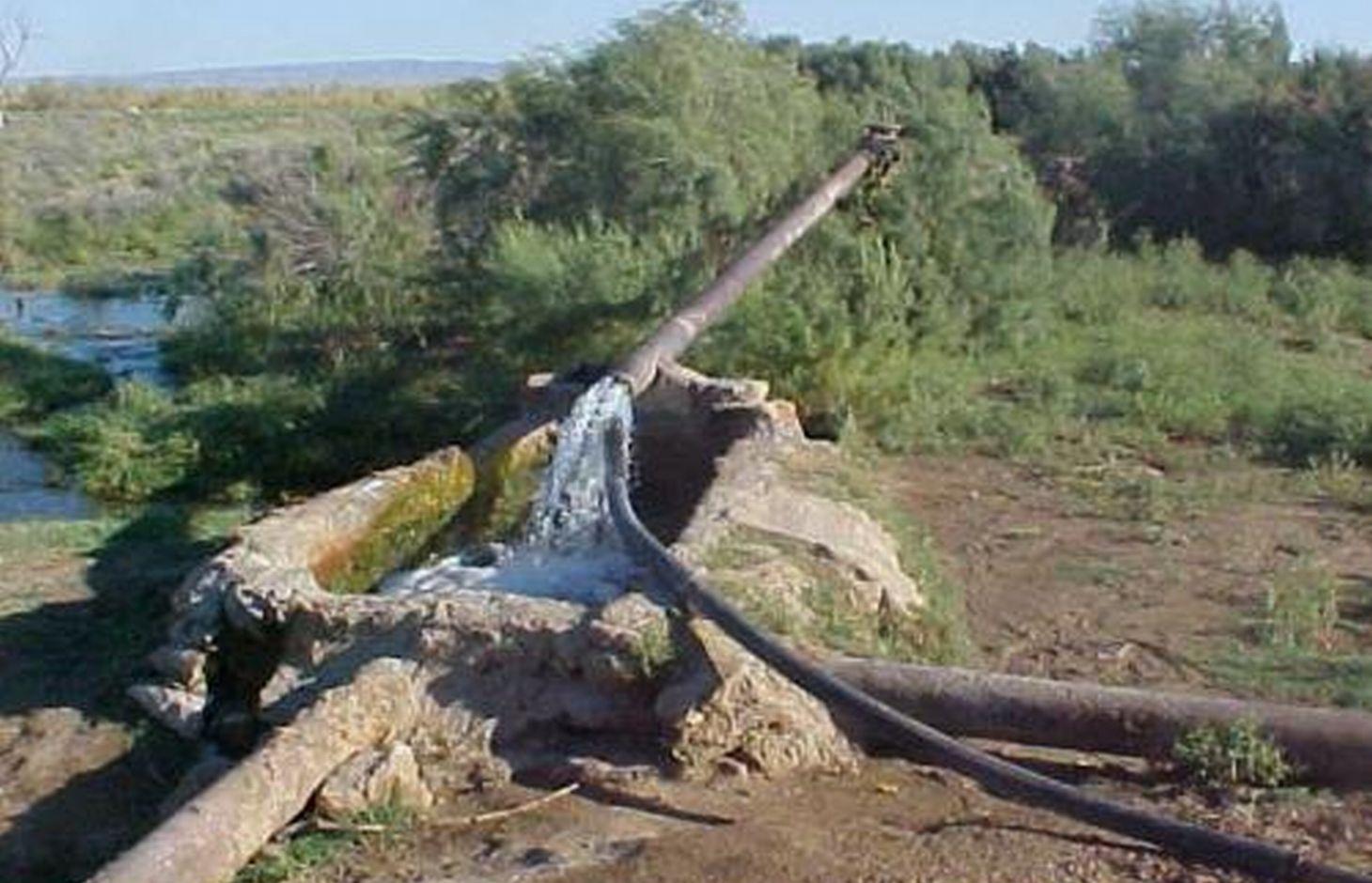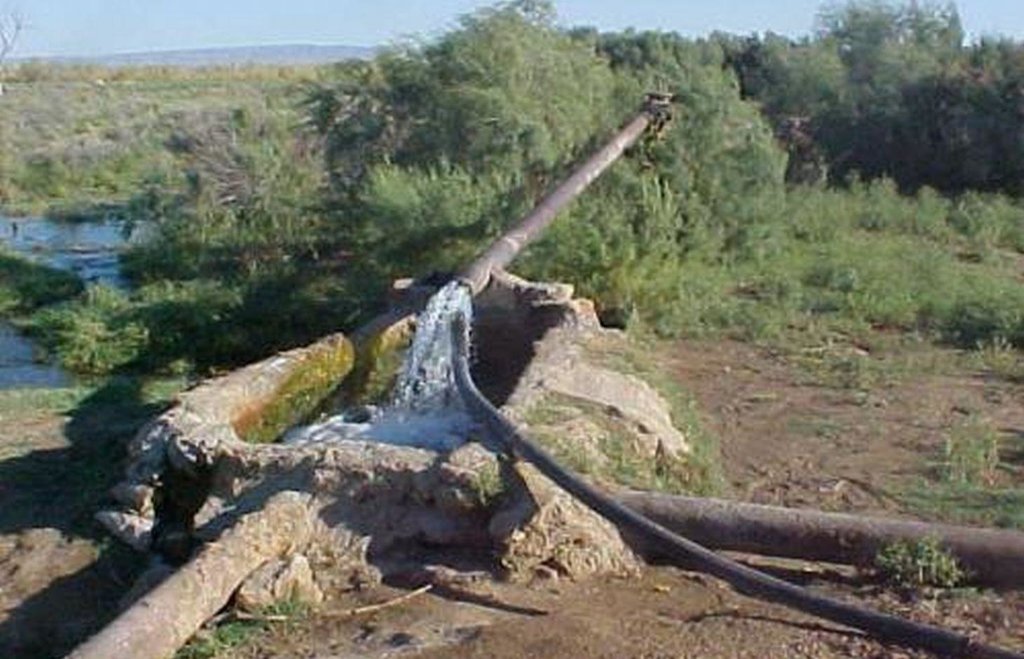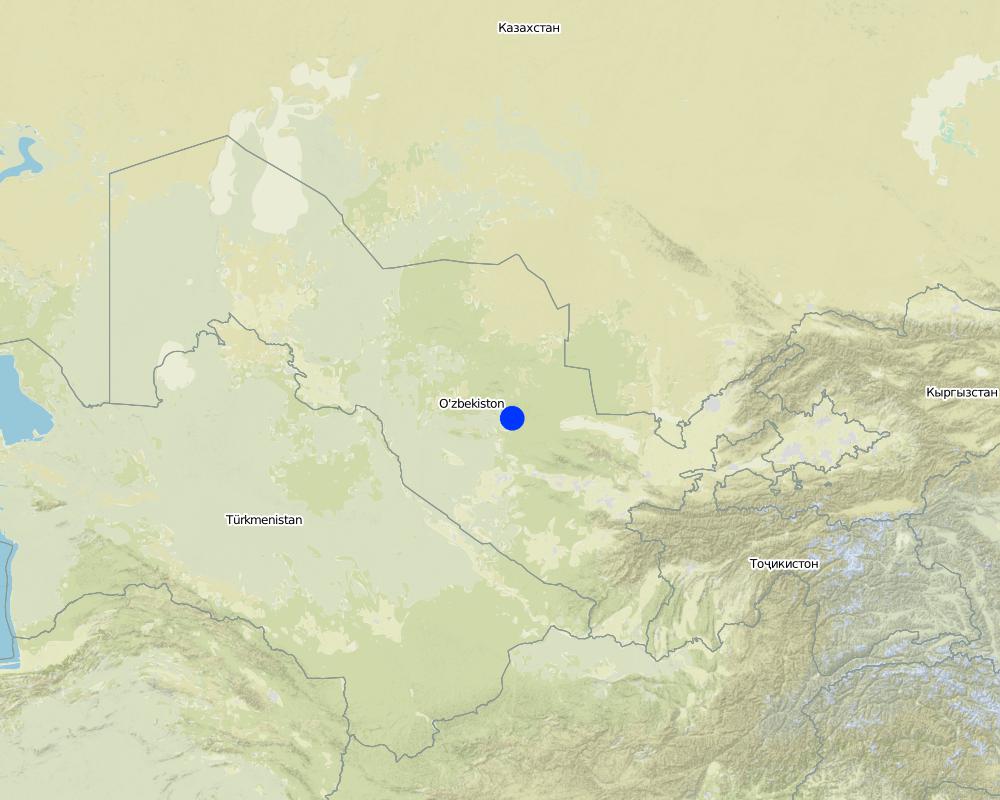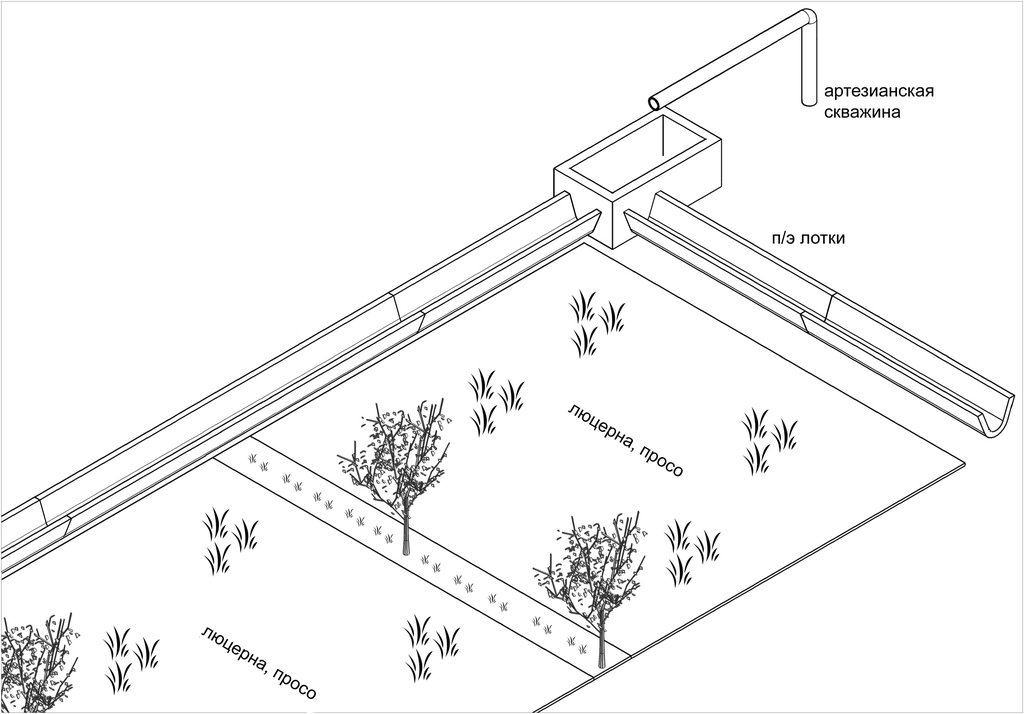Use of mineralized artesian water to organize irrigated crop farming in the Kyzylkum (CACILM) [Uzbekistan]
- Creation:
- Update:
- Compiler: Rustam Ibragimov
- Editor: –
- Reviewers: Alexandra Gavilano, David Streiff
Central Asia Countries' Initiatives for Land Management (CACILM)
technologies_1117 - Uzbekistan
- Full summary as PDF
- Full summary as PDF for print
- Full summary in the browser
- Full summary (unformatted)
- Use of mineralized artesian water to organize irrigated crop farming in the Kyzylkum (CACILM): April 28, 2017 (inactive)
- Use of mineralized artesian water to organize irrigated crop farming in the Kyzylkum (CACILM): Aug. 1, 2017 (inactive)
- Use of mineralized artesian water to organize irrigated crop farming in the Kyzylkum (CACILM): Aug. 2, 2017 (inactive)
- Use of mineralized artesian water to organize irrigated crop farming in the Kyzylkum (CACILM): Aug. 22, 2019 (public)
View sections
Expand all Collapse all1. General information
1.2 Contact details of resource persons and institutions involved in the assessment and documentation of the Technology
SLM specialist:
Mukimov Tolib
Research Institute of Karakul Breeding and Desert Ecology of Uzbekistan
Uzbekistan
SLM specialist:
Rabbimov Abdulla
Research Institute of Karakul Breeding and Desert Ecology of Uzbekistan
Uzbekistan
Name of the institution(s) which facilitated the documentation/ evaluation of the Technology (if relevant)
Central Asian Countries Initiative for Sustainable Land Management - Multicountry Capacity Building (CACILM - MCB) - KyrgyzstanName of the institution(s) which facilitated the documentation/ evaluation of the Technology (if relevant)
Research Institute of Karakul Breeding and Desert Ecology of Uzbekistan - Uzbekistan1.3 Conditions regarding the use of data documented through WOCAT
The compiler and key resource person(s) accept the conditions regarding the use of data documented through WOCAT:
Yes
2. Description of the SLM Technology
2.1 Short description of the Technology
Definition of the Technology:
Cultivating several food and forage crops in the Kyzylkum desert using mineralized irrigation water from a flowing artesian well
2.2 Detailed description of the Technology
Description:
Pasture-based livestock production is an important component of Uzbekistan’s agricultural sector, producing more than 60% of all the livestock output. Concentrated on an area of 17,5 mln. ha, it is based on the full or partial pasture keeping of animals. Assuming that the average pasture’s productivity is 1,7 centners/ha (100%), forage availability during spring is 80%, 100 % in the summer & autumn & 60-65% during winter. Total forage shortage in the Kyzylkum desert is about 540 thousand tons (15% of total demand). Considering this, production of reserve stock of forage is a relevant task.
The Kyzylkum desert has artesian wells, which each produce 13-15 l/s. Water in the wells has neutral acidity (pH- 7,4) & medium salinity (Ec= 5.6-8.3 ds/m). The technology of salinity tolerant crops (halophytes) for livestock forage was introduced on the basis of irrigation using water from these wells. The suitability of these feeds to various groups of livestock animals was determined and a system of pre-feeding preparation was developed, taking into account the mineralization of irrigation water and quality of the halophytes (in the frame of CACILM).
Purpose of the Technology: The purpose of this technology is land improvement through retention of topsoil, rehabilitation of vegetation cover, prevention of overgrazing through reducing livestock pressure by organizing irrigated forage production.
Establishment / maintenance activities and inputs: The agricultural processes for establishing irrigated land are traditional and include plot leveling, plowing, chiseling, harrowing, sowing, cutting irrigation furrows and caring for the plantation. The following forage crops were successfully tested: winter cereal crops (Movlono barley, Kyrgyzskaya-1 rye, Prag Serebristy triticale, Kroshka millet), forage crops (Belozubaya maize, Aip-13150 pearl millet, Oq Zhuhori and Venichnoe sorghum, Sudan grass, Tashkentskaya and Eureca alfalfa, D-1 and D-2, common licorice) & forage halophytes (К. scoparia (L.) Schrad, Bassia hyssopifolia (Pallas) O. Kuntze, S. altissima & Climacoptera lanata).
Natural / human environment: Using mineralized waters for irrigation is only possible in soils with a light texture The introduction of crop rotation with halophytes, which remove up to 40% of salts from the soil, is also mandatory for the ecologically sustainable application of saline water. Traditionally livestock production is the main source of income for the population of the Kyzylkum and important to create family savings. To improve their livelihoods, livestock numbers are increased without consideration of the area or condition of pastures. Unsystematic grazing and pasture use beyond its capacity threatens biodiversity. Forage production facilitates the creation of a reserve stock of forage and alleviates pressure on the pastures. There are 63 artesian wells in the Kanimekh district, which can be used for irrigated crop farming on an area of 350-400 ha. In the Kyzylkum desert, this technology may be introduced on an area of 25 000 ha.
2.3 Photos of the Technology
2.5 Country/ region/ locations where the Technology has been applied and which are covered by this assessment
Country:
Uzbekistan
Region/ State/ Province:
Uzbekistan / Navoi oblast
Further specification of location:
Kanimekh district
Specify the spread of the Technology:
- applied at specific points/ concentrated on a small area
Comments:
Total area covered by the SLM Technology is 0.03 km2.
Pasture with thin herbaceous desert vegetation in Kyzylkum desert near a flowing artesian well with mineralized water. Soil cover is represented by sandy soils with high water permeability.
Map
×2.6 Date of implementation
If precise year is not known, indicate approximate date:
- less than 10 years ago (recently)
2.7 Introduction of the Technology
Specify how the Technology was introduced:
- during experiments/ research
- through projects/ external interventions
Comments (type of project, etc.):
Experiments and research on the use of mineralized artesian water for irrigation of forage crops were performed by Uzbek scientists 40 years ago. This technology was introduced under the framework of ICARDA project “Research on Sustainable Land Resources Management” Experiments 4 and 5 «Zone of rehabilitation of pasture lands» in 2007-2009.
3. Classification of the SLM Technology
3.1 Main purpose(s) of the Technology
- reduce, prevent, restore land degradation
3.2 Current land use type(s) where the Technology is applied

Cropland
- Annual cropping
Annual cropping - Specify crops:
- fodder crops - other
- fodder crops - alfalfa
Number of growing seasons per year:
- 1
Specify:
Longest growing period in days: 220; Longest growing period from month to month: April-November

Grazing land
Extensive grazing:
- Semi-nomadic pastoralism
- 10-25 LU /km2
- Livestock production farm comprised mainly of small ruminants
Comments:
Major land use problems (compiler’s opinion): A low natural fertility level of desert soils and extremely arid conditions (low precipitation, low air humidity and high summer temperatures)
Major land use problems (land users’ perception): Low quality soils and an arid climate
Future (final) land use (after implementation of SLM Technology): Grazing land: Gi: Intensive grazing/ fodder production
3.3 Has land use changed due to the implementation of the Technology?
Has land use changed due to the implementation of the Technology?
- Yes (Please fill out the questions below with regard to the land use before implementation of the Technology)
Land use mixed within the same land unit:
Yes
Comments:
Землепользование после внедрения УЗП технологии: Пастбище: Gi: Интенсивный выпас/ выращивание кормов
Если использование земель изменилось с началом применения Технологии, укажите тип землепользования до применения Технологии:
Пастбище: Ge: Экстенсивное животноводство
3.4 Water supply
Water supply for the land on which the Technology is applied:
- rainfed
3.5 SLM group to which the Technology belongs
- improved ground/ vegetation cover
- irrigation management (incl. water supply, drainage)
3.6 SLM measures comprising the Technology

agronomic measures
- A1: Vegetation/ soil cover
- A2: Organic matter/ soil fertility

management measures
- M1: Change of land use type
Comments:
Type of agronomic measures: mixed cropping / intercropping, mineral (inorganic) fertilizers, furrows (drainage, irrigation)
3.7 Main types of land degradation addressed by the Technology

soil erosion by water
- Wt: loss of topsoil/ surface erosion

biological degradation
- Bc: reduction of vegetation cover
Comments:
Secondary types of degradation addressed: Et: loss of topsoil
Main causes of degradation: overgrazing (unsystematic grazing and excessive load on the pasture), droughts (low rainfall, poor natural vegetation)
3.8 Prevention, reduction, or restoration of land degradation
Specify the goal of the Technology with regard to land degradation:
- prevent land degradation
Comments:
Основная цель: предупреждение деградации земель
4. Technical specifications, implementation activities, inputs, and costs
4.1 Technical drawing of the Technology
Technical specifications (related to technical drawing):
Water from a flowing well is supplied by gravity via a ditch or plastic chute assembly with outlets feeding the irrigation furrows.
Location: shirkat farm Madaniyat. Kanimekh district/Navoi oblast
Date: 10-10-2011
Technical knowledge required for field staff / advisors: moderate
Technical knowledge required for land users: moderate
Main technical functions: improvement of ground cover, increase in organic matter, increase in nutrient availability (supply, recycling,…), promotion of vegetation species and varieties (quality, eg palatable fodder), Crop rotation includes halophytes and alfalfa
Mixed cropping / intercropping
Material/ species: halophytes and alfalfa
Quantity/ density: 10-20kg/ha
Remarks: every 4 years with a sowing rate of 20kg/ha (alfalfa) and 10-12 kg/ha (halophytes)
Mineral (inorganic) fertilizers
Material/ species: carbamide
Quantity/ density: 100 kg/ha
Furrows (drainage, irrigation)
Material/ species: irrigation head-ditches
Quantity/ density: 100 m/ha
Change of land use type: pastures converted into irrigated plough land
Author:
R.Ibragimov, UZGIP institute, 44, Navoi str, Tashkent, Uzbekistan
4.2 General information regarding the calculation of inputs and costs
Specify currency used for cost calculations:
- USD
other/ national currency (specify):
Узбекский сум
Indicate average wage cost of hired labour per day:
10.00
4.3 Establishment activities
| Activity | Timing (season) | |
|---|---|---|
| 1. | Mobile irrigation plastic chute assembly |
4.4 Costs and inputs needed for establishment
| Specify input | Unit | Quantity | Costs per Unit | Total costs per input | % of costs borne by land users | |
|---|---|---|---|---|---|---|
| Equipment | Mobile irrigation plastic chute assembly | meter | 50.0 | 18.2 | 910.0 | |
| Total costs for establishment of the Technology | 910.0 | |||||
| Total costs for establishment of the Technology in USD | 910.0 | |||||
Comments:
Duration of establishment phase: 3 month(s)
4.5 Maintenance/ recurrent activities
| Activity | Timing/ frequency | |
|---|---|---|
| 1. | Leveling, plowing, compactor, cutting irrigation furrows | Autumn |
| 2. | Sowing | March-April |
| 3. | Caring for plantations (irrigations) | April-October |
| 4. | Mowing | June, July, August |
| 5. | Protection of the site | Year round |
4.6 Costs and inputs needed for maintenance/ recurrent activities (per year)
| Specify input | Unit | Quantity | Costs per Unit | Total costs per input | % of costs borne by land users | |
|---|---|---|---|---|---|---|
| Labour | Leveling, plowing, compactor, cutting irrigation furrows | machine/hr | 6.0 | 20.33 | 121.98 | 100.0 |
| Labour | Sowing | machine/hr | 1.5 | 9.8 | 14.7 | 100.0 |
| Labour | Caring for plantations | people/month | 4.0 | 244.75 | 979.0 | 100.0 |
| Labour | Mowing | machine/hr | 2.0 | 17.5 | 35.0 | 100.0 |
| Plant material | Seeds | kg/ha | 20.0 | 3.495 | 69.9 | |
| Fertilizers and biocides | Fertilizer | kg/ha | 100.0 | 0.266 | 26.6 | 100.0 |
| Other | Labour: Protection of the site | persons/month | 12.0 | 70.0 | 840.0 | 100.0 |
| Total costs for maintenance of the Technology | 2087.18 | |||||
| Total costs for maintenance of the Technology in USD | 2087.18 | |||||
Comments:
Machinery/ tools: Tractor, long-wheelbase leveler, plough, harrow, compactor
The cost was estimated for 1 hectare (as of 2009).
4.7 Most important factors affecting the costs
Describe the most determinate factors affecting the costs:
Using plastic chutes for long-line furrow irrigation is not a mandatory element of the technology. In general, the technology is very cheap. The largest cost incurred is the hiring of labour to care for the seedlings during the vegetation period.
5. Natural and human environment
5.1 Climate
Annual rainfall
- < 250 mm
- 251-500 mm
- 501-750 mm
- 751-1,000 mm
- 1,001-1,500 mm
- 1,501-2,000 mm
- 2,001-3,000 mm
- 3,001-4,000 mm
- > 4,000 mm
Specifications/ comments on rainfall:
Total amount of precipitation is 106 mm/year, 90% of precipitation falls from October to May
Agro-climatic zone
- semi-arid
Thermal climate class: temperate. For 3 months, the air temperature is < 5 оС and for 7 months, it is > 10 оС
5.2 Topography
Slopes on average:
- flat (0-2%)
- gentle (3-5%)
- moderate (6-10%)
- rolling (11-15%)
- hilly (16-30%)
- steep (31-60%)
- very steep (>60%)
Landforms:
- plateau/plains
- ridges
- mountain slopes
- hill slopes
- footslopes
- valley floors
Altitudinal zone:
- 0-100 m a.s.l.
- 101-500 m a.s.l.
- 501-1,000 m a.s.l.
- 1,001-1,500 m a.s.l.
- 1,501-2,000 m a.s.l.
- 2,001-2,500 m a.s.l.
- 2,501-3,000 m a.s.l.
- 3,001-4,000 m a.s.l.
- > 4,000 m a.s.l.
Comments and further specifications on topography:
Landforms: Virtually zero slope
Altitudinal zone: Elevation is 125-190 m above sea level
5.3 Soils
Soil depth on average:
- very shallow (0-20 cm)
- shallow (21-50 cm)
- moderately deep (51-80 cm)
- deep (81-120 cm)
- very deep (> 120 cm)
Soil texture (topsoil):
- coarse/ light (sandy)
Topsoil organic matter:
- low (<1%)
If available, attach full soil description or specify the available information, e.g. soil type, soil PH/ acidity, Cation Exchange Capacity, nitrogen, salinity etc.
Soil depth on average: Deep desert-sandy and gray-brown soils
Soil texture (topsoil): 0.01 mm particle content up to 10%
Soil fertility is low (30-40 points out of a 100-point scale )
Soil drainage / infiltration is good, stipulated by light texture of desert soil
Soil water storage capacity is low with a capacity of 15-19%
5.4 Water availability and quality
Ground water table:
5-50 m
Availability of surface water:
medium
Water quality (untreated):
for agricultural use only (irrigation)
Comments and further specifications on water quality and quantity:
Availability of surface water: During irrigation, groundwater table rises by up to 2 m
Water quality (untreated): Underground water has a neutral pH, acid reaction = 7.4 and the average salinity - Ec = 5,6-8,3 ds / m
5.5 Biodiversity
Species diversity:
- low
Comments and further specifications on biodiversity:
Desert grass vegetation is adapted to harsh desert conditions
5.6 Characteristics of land users applying the Technology
Market orientation of production system:
- mixed (subsistence/ commercial)
Off-farm income:
- less than 10% of all income
Individuals or groups:
- cooperative
Gender:
- men
Indicate other relevant characteristics of the land users:
Land users applying the Technology are mainly common / average land users
Population density: < 10 persons/km2
Annual population growth: 1% - 2%
5.7 Average area of land used by land users applying the Technology
- < 0.5 ha
- 0.5-1 ha
- 1-2 ha
- 2-5 ha
- 5-15 ha
- 15-50 ha
- 50-100 ha
- 100-500 ha
- 500-1,000 ha
- 1,000-10,000 ha
- > 10,000 ha
Is this considered small-, medium- or large-scale (referring to local context)?
- medium-scale
5.8 Land ownership, land use rights, and water use rights
Land ownership:
- state
Land use rights:
- leased
Comments:
Shirkats (large agricultural cooperatives) are granted public land for permanent ownership, which is then assigned to the shirkat members under rent conditions
5.9 Access to services and infrastructure
health:
- poor
- moderate
- good
education:
- poor
- moderate
- good
technical assistance:
- poor
- moderate
- good
employment (e.g. off-farm):
- poor
- moderate
- good
markets:
- poor
- moderate
- good
energy:
- poor
- moderate
- good
roads and transport:
- poor
- moderate
- good
drinking water and sanitation:
- poor
- moderate
- good
financial services:
- poor
- moderate
- good
6. Impacts and concluding statements
6.1 On-site impacts the Technology has shown
Socio-economic impacts
Production
fodder production
Comments/ specify:
Due to the cultivation of forage crops
animal production
Comments/ specify:
Due to the improvement of availability of forage
Income and costs
farm income
Comments/ specify:
Due to an increase in livestock production
Socio-cultural impacts
food security/ self-sufficiency
Comments/ specify:
Due to an increase in livestock production
health situation
Comments/ specify:
An increase in livestock production leads to an improvement in the population’s health
livelihood and human well-being
Comments/ specify:
An increase in livestock production due to improved forage availability facilitates an increase in the shirkat farm’s income, and therefore, the livelihoods for its members is improved
Ecological impacts
Soil
soil moisture
Comments/ specify:
Due to irrigation
soil loss
Comments/ specify:
The surface is covered by vegetation and is less affected by wind erosion
nutrient cycling/ recharge
Comments/ specify:
Due to the accumulation of nitrogen in nodule bacterium on alfalfa roots
salinity
Comments/ specify:
There is a risk of an increase in soil salinity if the technology were to breakdown (if halophytes were to excluded from crop rotation)
soil organic matter/ below ground C
Comments/ specify:
Due to the decomposition of plants’ residues and root system
Biodiversity: vegetation, animals
biomass/ above ground C
Comments/ specify:
The surface is covered by forage and other plants
6.3 Exposure and sensitivity of the Technology to gradual climate change and climate-related extremes/ disasters (as perceived by land users)
Gradual climate change
Gradual climate change
| Season | increase or decrease | How does the Technology cope with it? | |
|---|---|---|---|
| annual temperature | increase | well |
Climate-related extremes (disasters)
Meteorological disasters
| How does the Technology cope with it? | |
|---|---|
| local rainstorm | well |
| local windstorm | well |
Climatological disasters
| How does the Technology cope with it? | |
|---|---|
| drought | well |
Hydrological disasters
| How does the Technology cope with it? | |
|---|---|
| general (river) flood | not well |
Other climate-related consequences
Other climate-related consequences
| How does the Technology cope with it? | |
|---|---|
| reduced growing period | well |
Comments:
The technology is stable regardless of climate change, since it is based on flowing wells, which are a guaranteed source of water. The crops grown are also biologically adapted to unfavorable desert conditions (dry winds, droughts, high temperatures, etc.).
6.4 Cost-benefit analysis
How do the benefits compare with the establishment costs (from land users’ perspective)?
Short-term returns:
very positive
Long-term returns:
very positive
How do the benefits compare with the maintenance/ recurrent costs (from land users' perspective)?
Short-term returns:
positive
Long-term returns:
very positive
Comments:
Short-term: forage production, vegetables and melons, providing livestock with wholesome food during autumn and winter and food products to the population
Long-term: preservation and increase of biodiversity, reduction in the pressure on pastures.
6.5 Adoption of the Technology
- > 50%
If available, quantify (no. of households and/ or area covered):
20 households in an area of 3 ha
Of all those who have adopted the Technology, how many did so spontaneously, i.e. without receiving any material incentives/ payments?
- 0-10%
Comments:
20 land user families have adopted the Technology with external material support
There is no trend towards spontaneous adoption of the Technology
Comments on adoption trend: due to a lack of farming standards in the local population’s traditional livestock production
6.7 Strengths/ advantages/ opportunities of the Technology
| Strengths/ advantages/ opportunities in the land user’s view |
|---|
|
Quick income generation and low level of investment into the technology How can they be sustained / enhanced? Training in irrigated agriculture and apply knowledge in practice |
| Strengths/ advantages/ opportunities in the compiler’s or other key resource person’s view |
|---|
|
No special investment is required to introduce the technology How can they be sustained / enhanced? To promote and persuade farmers to engage in pastoral irrigated fodder production |
|
Quick income generation; Up to 1.5 million Sum of net profit per hectare can be generated How can they be sustained / enhanced? Perform all the activities provided measures technology to observe crop rotation |
|
Locally available resources and materials are used How can they be sustained / enhanced? Use offered salt-tolerant varieties the technology of fodder crops |
|
Availability of a guaranteed source for irrigation water provides for the sustainability of production How can they be sustained / enhanced? Use recomendations in irrigation mineralized artesian waters |
|
Creates employment opportunities, increases employment and production growth How can they be sustained / enhanced? To promote and persuade farmers to engage in pastoral irrigated fodder production |
6.8 Weaknesses/ disadvantages/ risks of the Technology and ways of overcoming them
| Weaknesses/ disadvantages/ risks in the land user’s view | How can they be overcome? |
|---|---|
| Lack of equipment and farming traditions | Change the mentality and habits |
| Weaknesses/ disadvantages/ risks in the compiler’s or other key resource person’s view | How can they be overcome? |
|---|---|
| Lack of agricultural machinery personally owned by the local land users involved in livestock production | Farmers association into groups for the joint acquisition of equipment |
| Lack of farming standards and experience among the local population traditionally practicing livestock production | Training in irrigated agriculture, promotion of technology |
| Possible tendency to soil salinization | Strict adherence to recommendations for crop rotation. Monitoring of soil salinity |
7. References and links
7.1 Methods/ sources of information
Links and modules
Expand all Collapse allLinks
No links
Modules
No modules






